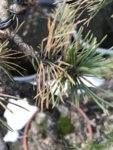Velodog2
Chumono
I’ve been growing this pine for ages - at least ten years - slowly developing the branches. I always prune in the fall. This past fall I was finally seeing the design coming together and the tree was very healthy so I got a little cocky with the pruning, taking some of the branches back to the next bud and removing some but not all of this years growth.
Now I’m seeing the two year old needles shriveling. Not abscissing and dropping off just dying. Last years needles are still fine, as are the buds it seems. But it’s never done this and I don’t think it’s right.
What did I do wrong? What do you think it’s chances are for the spring? I’m constantly reminded I don’t really know what I’m doing ...
Now I’m seeing the two year old needles shriveling. Not abscissing and dropping off just dying. Last years needles are still fine, as are the buds it seems. But it’s never done this and I don’t think it’s right.
What did I do wrong? What do you think it’s chances are for the spring? I’m constantly reminded I don’t really know what I’m doing ...




